If you ask me what my favourite noodle is, no question it's these soft and chewy fresh rice noodles that we use in cult favourite dishes like Pad See Ew. While it's not always easy to find, this homemade recipe is simple with only 2 ingredients, and it's much better than any store bought versions I've tried! And yes, you can freeze them!
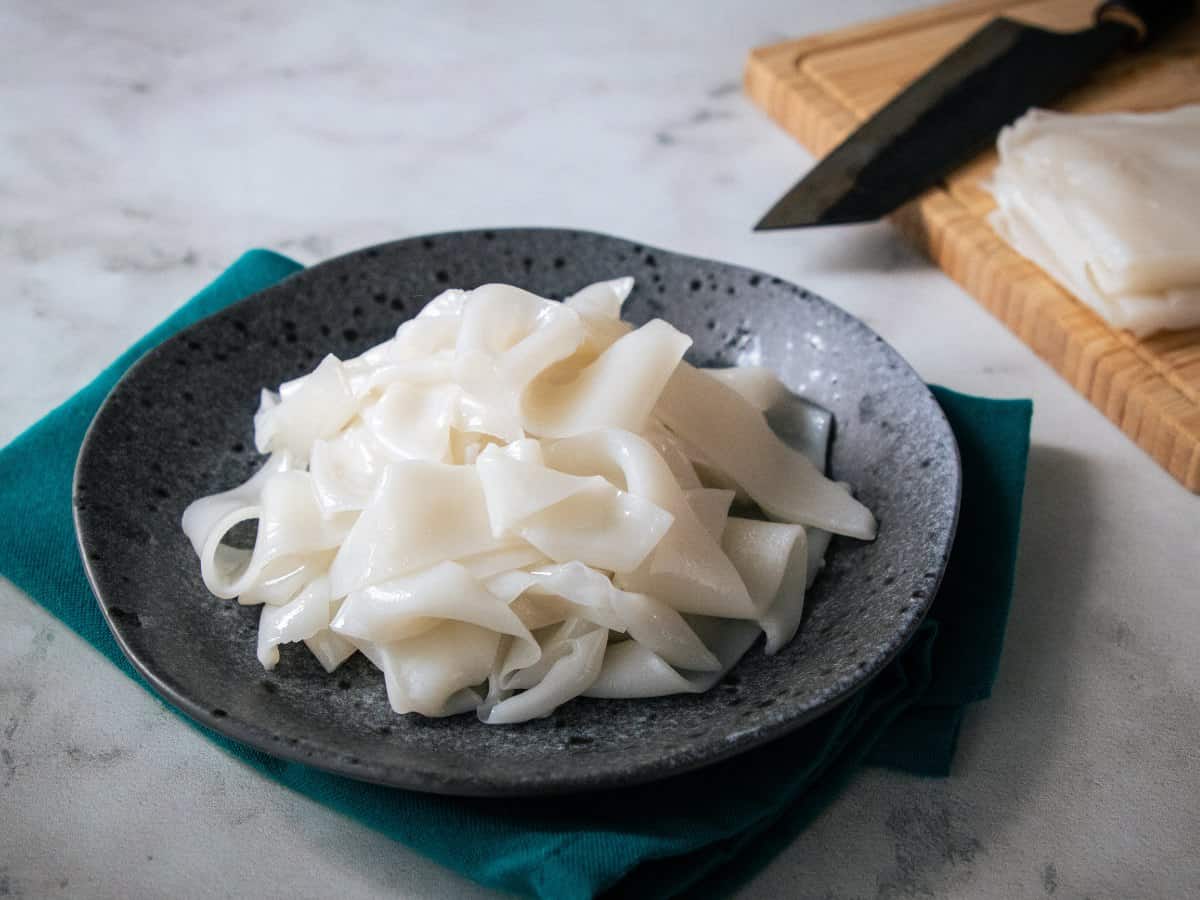
Want to save this recipe?
Ingredients and Important Notes
There are only 2 ingredients needed, not counting the water and the oil. Pay attention to my notes as it's crucial you use the right ingredients. For amounts, see the full recipe card below.
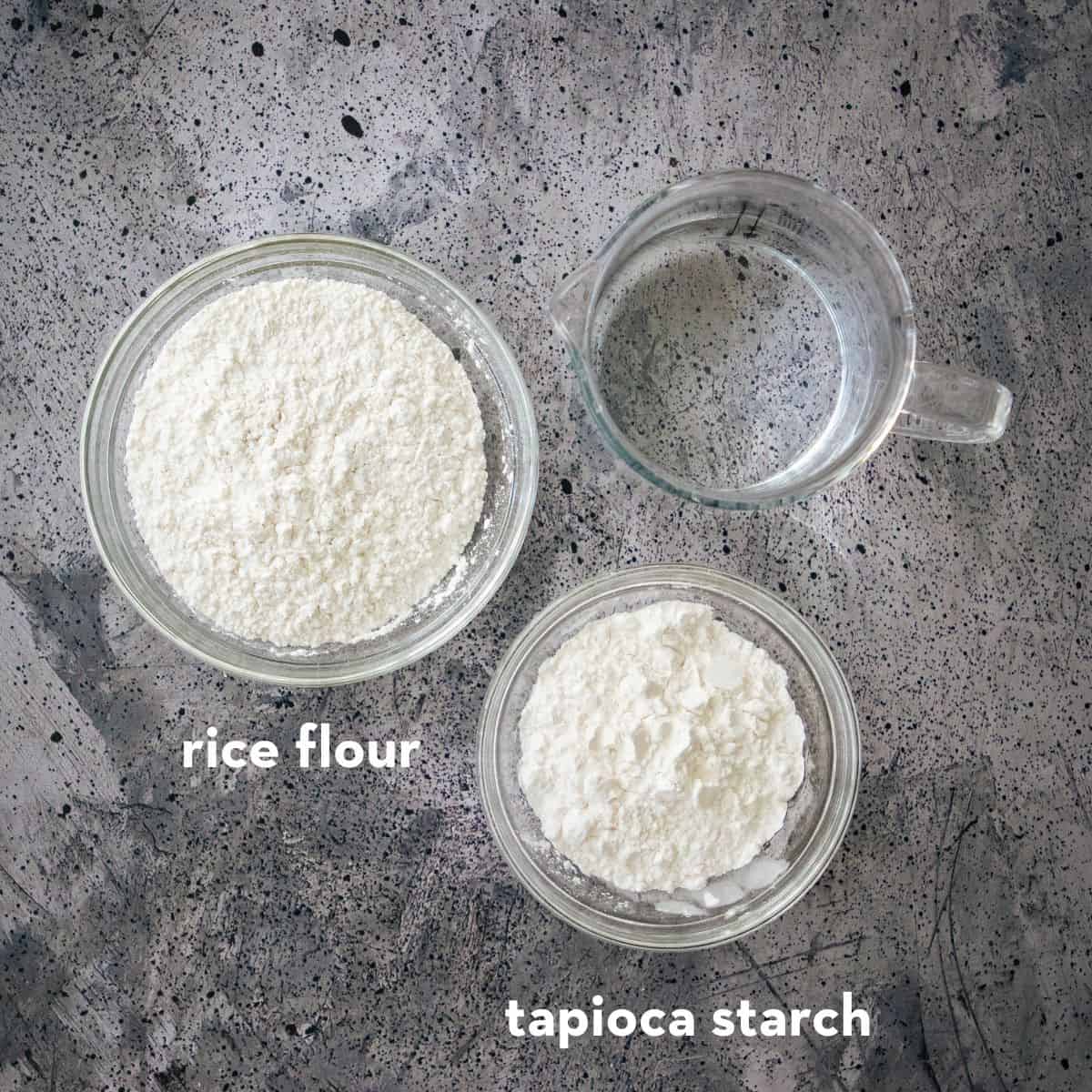
- Thai Rice flour. Make sure you buy rice flour from Thailand to ensure your noodles have the right texture. Rice flour made in the US is sometimes milled differently and cannot be used in this recipe. Also note that we need regular rice flour, which will be labelled simply as "rice flour" on the bag. Do NOT use glutinous rice flour as the two are very different and are not interchangeable in any recipe.
- Thai Tapioca starch. Tapioca starch is added to give the noodles their chewiness and elasticity. Again, you want to get Thai tapioca starch to ensure the correct product, and do not get "tapioca flour" which is not the same.
- Neutral flavoured oil. While not an ingredient for the noodles, you will need the oil to brush the pan and the noodles to prevent sticking. These noodles are very sticky without the oil! If you're not cooking the noodles right away and will need to refrigerate them, do not use oil that hardens in the fridge such as avocado or coconut oil.
The Gear

Though the recipe is very simple, it's important to have the right equipment for smooth, successful noodle making. Here's what you need:
- A large steamer. A diameter of 14 inches is ideal as it'll fit a good size pan. If you don't have a Chinese style multi-tier steamer, you can place a steamer rack inside a wok or a large dutch oven provided you have a lid for it.
- A pan for steaming noodles. My easiest solution is to use a cheap non-stick cake pan you can find at any dollar stores, or a stainless steel prep tray common in Japanese dollar stores. And "cheap" is because these tend to be the thinnest which is what we want.
Here are the characteristics of a good pan for making noodle sheets:- Thin metal pan that is smooth. Thin and metal will ensure that each noodle sheet cools down quickly, which will speed up the process. Smoother surfaces such as stainless steel or non-stick will release the noodles more easily.
- Non-stick, preferably. Nonstick pans makes peeling noodles off easier, but it's not a deal breaker. Stainless steel also works with a little more fussing as you can see in the video tutorial.
- As big as will fit into your steamer. The bigger the pan, the fewer sheets you have to make, reducing the total cooking time.
- Rectangles are better, but round is fine. Rectangles will create evenly sized noodles, so go with this if you have a choice.
- Low sides. Since you have to get your hands in there to peel the noodle sheets, lower sides will make this easier to access. (So a loaf pan is not ideal for this reason).

- Steamer tongs (optional). This will help you grab things in and out of the steamer quickly and easily. They are available at any Asian grocery stores that carry some kitchen tools. Otherwise oven gloves/mitts are fine.
- Ice bath for cooling noodles (optional). To cool noodles down quickly, prepare an ice bath in a pan that's bigger than your noodle pan. Alternatively you can rinse the back of the pan under running cold tap water.
Step-by-Step: How to Make Fresh Rice Noodles
Here's a bird's eye view of the process, but if it's your first time I highly recommend watching the video tutorial to ensure success. You'll have a much better idea of what to do after watching the video!

- Combine the rice flour and tapioca starch, then add water little by little, just until a soft dough forms.
- Knead the dough for about 5 minutes (info on why kneading is done below).
- Add the rest of the water all at once and use your hand to swish it around to dissolve it into a smooth batter.
- Let it rest while you set up the steamer, bringing the water to a full boil.

- Lightly but thoroughly oil your pan - using paper towel is better than a brush for this as I find a brush leaves too much oil. While you're at it also oil the plate/tray you're going to use to place cooked noodles.
- Place the pan on the steamer, then stir the batter well and pour in the required amount of batter (see below for how much batter you need per sheet). Initially the batter will run to one side; use steamer tongs (or oven gloves) to wiggle the pan to even out the batter. As some of the batter cooks and clings to the pan, you will be able to get a full coverage.
- Once the batter is evenly spread out, cover and steam for about 1 minute.
- When it's done, the top will look matt and you may get air bubbles underneath the noodle sheet.

- Let the noodles cool completely. I suggest preparing an ice bath or running cold tap water over the back of the pan to cool it quickly.
- Once completely cooled, brush the top with a generous amount of oil.
- Use a rubber spatula to free the edges from the pan; if using nonstick, this may not be necessary but always check to make sure the edges have released.
- Slowly peel the noodles off the pan.
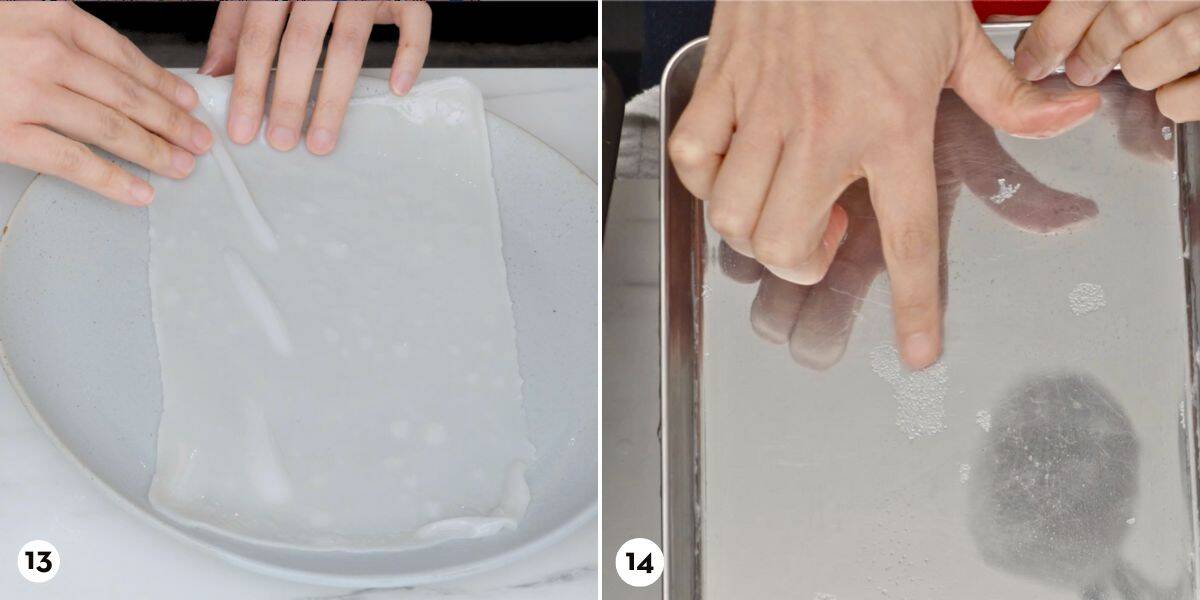
- Place the noodles down on an oiled plate.
- If on the pan there is a big patch of residual batter left on, scrub it off with a dish brush before you do your next sheet. Small spots here and there is fine. Repeat the process, being sure to re-oil the pan each time.
How Much Batter To Use - A Formula
It's obvious but it must be said, how much batter you need per sheet of noodle will depend on the size of the pan you're using, so here's a formula for calculating the amount of batter required (roughly).
Surface area of pan in sq. in. x 1.1 ml = amount of batter per sheet (ml)
So calculate the surface area of your pan in square inches (remember geometry class?), multiply it by 1.1, then round up/down to an amount that's easy enough to measure as it does not have to be super precise.
For example, my 8-inch round pan has a surface area of 50 sq.in., multiplied by 1.1 gives me 55 ml. I round this up to 60 ml because that's a nice and even ¼ cup.
P.S. I got this ratio from figuring out by trial and error that ¼ cup (60 ml) is the perfect amount for my my 9" x 6" pan. If based on my ratio you find that you prefer your noodles to be thicker or thinner, feel free to adjust the amount up/down!
Tip: Creating The Perfect Noodles - Kneading Explained
You might wonder why we need to bother kneading the dough only to then dilute it into a batter. Why not just add all the water at once?
This is actually a technique that can be seen in Thai dessert recipes involving starches. The kneading essentially forces the starch molecules to absorb water more quickly, allowing the starch to fully hydrate more quickly.
Why does this matter? Because fully-hydrated starch yields softer, shinier, and chewier noodles.
This means then, that if you didn't want to knead, you can also just let the batter rest overnight to allow the starch to slowly hydrate on its own. The kneading just speeds it up.
As explained by Dr. Teeprakorn Kongraksawech, a food scientist from Oregon State University who told me:
In an industry level, a flour slurry is allowed to equilibrate for many hours before cooking it so flour becomes fully hydrated. A study compared noodles made from a 27-hr slurry vs a 3-hr slurry. The 27-hr slurry noodles were shinier, softer, and chewier. For a household/small-scale level, we may not want to wait that long. Slowly adding water and kneading will allow the flour to absorb more water.
So there, you can either knead or wait for the perfect noodles.
Storing Noodles in the Fridge
While I find that the best texture comes from noodles that were never refrigerated nor frozen, it's not always possible or practical. Storing noodles in the fridge AND freezing are possible, and the noodles will still have a great texture in the finished dish. However, there are some important tips to keep in mind.
Tips for Refrigerating Fresh Noodles
- Refrigerated noodles will last up to one week, though it's best to cook them as soon as possible. The longer they've been in the fridge, the stiffer they become, which makes them easy to break when handling. My preference is to make the noodles on one day, and cook them the next day when they're still quite soft and pliable.
- It's easiest to store noodles in whole sheets, well-wrapped to prevent drying out.
- When you take them out, peel the sheets apart first and restack them on the cutting board before cutting them into noodles. This makes separating the noodles easier as they are not so tightly packed together.
- If the noodles have hardened to a point where they are easy to break when you bend them, microwave them until they're hot which will soften them up again. Don't put stiff noodles directly into the wok as they will break when you stir them.
How to Freeze Fresh Rice Noodles
I spent years assuming that these couldn't be frozen because...well, they look so delicate, and if they could be frozen then why are they not available frozen at the store?? But after realizing they are in fact assumptions, I experimented with freezing. Turns out, they freeze very well! Follow the steps before for the best result.
- After cooking, divide noodle sheets into thin stacks (no more than 8 sheets per stack) so they thaw quickly.
- Cut the noodles into strips, but don't peel them apart - leave them in neat stacks so they take up less room in the freezer.
- Wrap them tightly in plastic wrap, keeping them flat and thin so they freeze and thaw quickly. Freezing and thawing quickly will produce small ice crystals which will yield the best results.
- Place them in a freezer bag, getting out as much air as possible, and freeze them on a flat surface. If you've got multiple stacks, don't put them on top of each other at first so they freeze quickly. After they're frozen, you can consolidate them.
- When ready to use, bring them out and let them thaw at room temp while you prep your ingredients.
- When you're ready to cook, remove the wrap and place them on a plate and microwave in 1 minute increments at about 70% power, taking them out after each minute to rearrange for even heating. Once they are hot, soft and elastic, peel them apart into individual noodles. They are now ready to be added to a wok or put directly into a noodle soups. They are amazing in the famous boat noodles!
Note: In my experiments I froze my noodles for 1 week. There shouldn't be a problem with freezing them for 1-2 months, but eventually they will get freezer burned especially if they're not contained in a heavy-duty freezer bag.
Recipes for Your Fresh Rice Noodles
Once you've got these amazing noodles, try them in any of these iconic Thai dishes below. While they're most commonly seen in stir fries, in Thailand they are also added to any kind of noodle soups. My favourite way to eat them is in pad see ew and boat noodles. *If using in noodle soups, reheat them in the microwave and place into a serving bowl, then pour hot noodle broth over them.
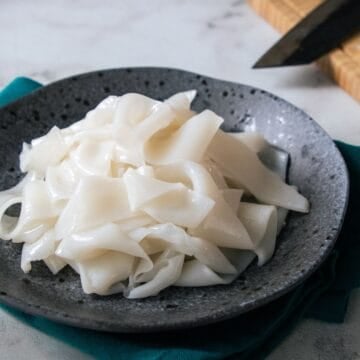
Homemade Fresh Rice Noodles (ho fun)
Equipment
- Pastry brush
- Thin nonstick cake pan or stainless steel trays (nonstick is preferred)
- Steamer
- Steamer tongs or oven gloves
Ingredients
- 1 cup Thai rice flour
- ½ cup Thai tapioca starch
- 1 ½ cups water
- ¼ cup neutral flavoured vegetable oil, for brushing
Want to save this recipe?
FULL VIDEO TUTORIAL
All my recipes come with step-by-step video tutorials with extra tips not mentioned in the blog post, so make sure you watch the video to ensure success. If you enjoy them, consider subscribing to the YouTube Channel to not miss an episode. Thank you!
Subscribe to my YouTube ChannelInstructions
- In a mixing bowl, add the rice flour and the tapioca starch and use your hand to mix just until combined.1 cup Thai rice flour, ½ cup Thai tapioca starch, 1 ½ cups water
- Add a little water at a time and mix just until it can form into a soft dough, then knead it for about 5 minutes.
- Add the remaining water to the dough and dissolve the dough into a smooth batter. Let it rest while you set up the steamer.
- Preheat the steamer and bring the water to a full boil. Oil your pan using folded paper towel dipped in oil, making sure you get the sides and the corners. Also oil the plate that you will use to put cooked noodle sheets on. If you want, prepare an ice bath to cool your noodle pan.¼ cup neutral flavoured vegetable oil
- Once the water is boiling, place the pan into the steamer. STIR THE BATTER WELL, then pour in the required amount of batter (see blog post above for the calculation for how much batter to use). Using steamer tongs or oven gloves, jiggle the pan until the batter covers the entire pan. Cover and steam for 1 minute.
- Once noodles are cooked, remove the pan from the steamer. Cool it completely in an ice bath or once the pan is cool enough to handle, rinse the back with cold tap water for 10-15 seconds.
- Once noodles are cooled completely, run a rubber spatula along the edges to make sure the edges are released, then gently peel the noodles off and place it on the oiled plate.
- Repeat with the remaining batter, oiling the pan each time and stirring the batter each time. If there is a lot of gumminess stuck to your pan, use a dish brush to scrub it off, but small spots here and there is fine. (To minimize gumminess, ensure your noodles are cooled completely before peeling). Stack the cooked noodles sheets on top of each other. If there is a thick side, make sure you put the thick side on the same side so we can trim them.
- Once you have all the noodles, you can cut into strips and use right away, or store them for later following storage tips in the blog post above. Then cut into strips. *I recommend cutting noodles to about ¾ inch wide.


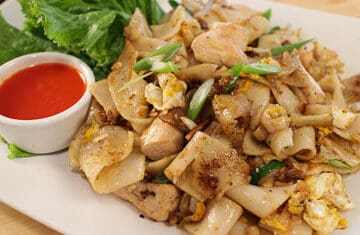
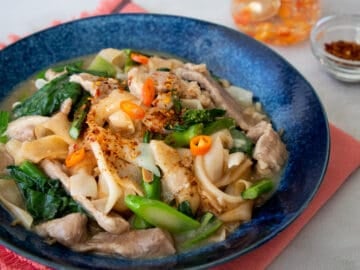
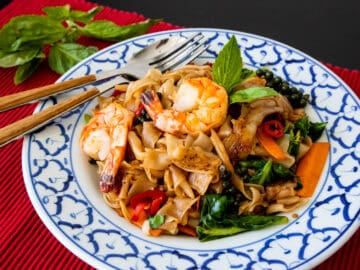
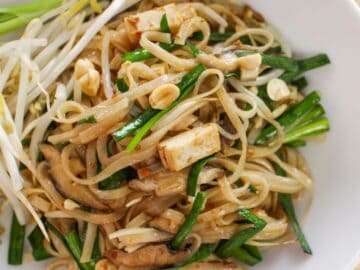
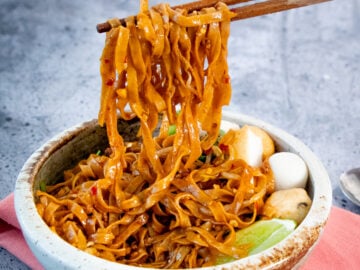
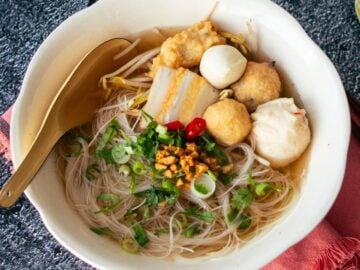
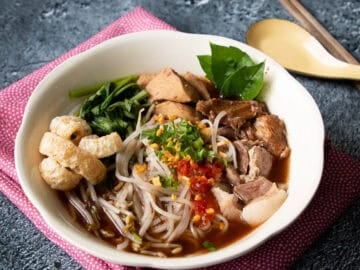
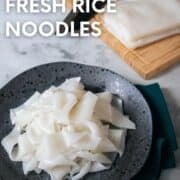
Eddy says
I feel like it's too obvious to not be the default approach if it works, but I couldn't help but wonder if just throwing everything into a blender would get you the same rapid hydration results. May test that out.
In any case, these came out great- surprisingly much better than store bought fresh noodles. Really gets Drunken Noodles even closer to restaurant quality. Maybe my seasoning is improving, but I swear these also don't stick as much.
This is probably one of those rare cases where the precision of a scale is unecssary but weighing would be a bit more convienient. These ingredients are very powdery to scoop and at least mine came in tiny bags. Next time I will record the grams.
Debbie says
Thanks for the tip! I'm waiting to get my tongs, which I ordered online. But I'm anxious to try this and don't want to burn my knuckles. Plus, regular potholders are too thick to maneuver between the side of the wok and the pan edge! So thank you so much!
Nyfallio says
I would be helpful if there was some more detail and explanation.
It is very difficult making them. The formula is way off. Even with less I need to seam several minutes. Otherwise there is a sticky tooth paste consistansy gel on my noodles.
When it got better they also seem to melt when I touched them with oil or a dip of water.
They also never came of at once. And when I steamed them longer the looked a bit cracked.
So, not really sure what the trick is…
Pat Forte says
I made these noodles and put them into a pad se ew dish. They were wonderful! I tried to attach a photo but seems I cannot. They were springy and chewy and seared just right.
Thanks Pailin. Will try to send it on Instagram!🥰❤️🙏
Kim says
Thank you so much for sharing the recipe and tutorial. I tried it yesterday and made my most favorite stir fried noodles with just egg and tofu. It broke into pieces but it was still super delicious. Next time I'll wait overnight and see if the texture can improve. I used a silicone pan which makes it super easy to peel the noodle sheet.
Kim says
I'm sorry, I missed out in my original comment that my most favorite stir fried noodles is pad see ew. I tried your noodle recipe again, i soaked the flour overnight and next day I discarded the clear water on top,replaced exact same amount of water and I did that 3 times. The noodles came out with more elasticity than last time but it still broke. However i still love it. Pad see ew sauce saved the meal!
Pailin Chongchitnant says
Hi Kim, the noodles should not break with or without the additional resting time. Are you using Thai rice flour and Thai tapioca starch? If so, it is most likely in your cooking technique, check out my post on mastering rice noodles, especially the video tutorial which shows how to prevent breaking. https://hot-thai-kitchen.com/rice-noodles-101/
Andrew says
If you don’t have steamer tongs, and especially if your steamer pan is a tight fit to the pot, you can fold a length of aluminum foil several times lengthwise to make a strip that sits under the steamer with the ends hanging out. Makes it easy to grab the ends and pull the pan out.
Angel says
Hi Pailin, can you please share the exact pans you're using for best results and the measured amount of batter you use each time?
Pailin Chongchitnant says
Been a while since I made it, will note this for when I update the recipe in the near future! But pan size doesn't matter, use whatever you have, and you'll just need to think of the first few sheets as a "trial" as you figure out the amount needed for your specific pan that gives you the thickness that you like.
David says
I haven’t made this but I do make homemade Cheug Fun and it is a similar process. Personally I use large and deep cooking pans (like 14-18” wide and about 3-4” deep). I fill a single pan with some water, place rolled up tin foil in the bottom lwith some above the water line. I use a 8x8 baking pan and fill it with batter. I cover the pan with another pan of the exact same size for a homemade steamer. I hope that that helps. It took me a while to figure out the above setup but works perfectly.
tana says
I saw some YouTube . they cook the batter in teflon pan rather than steam. why do you think.?
Pailin Chongchitnant says
I've never tried it myself so I can't comment on that. Probably works though!
A.B. says
Thank you so much for posting this recipe. Can't wait to try it!
Charlee says
I have made this recipe before and really enjoyed them in my Pad Kee Mao. How far in advance can these noodles be made prior to cooking them in the intended recipe?
Pailin Chongchitnant says
Glad to hear! So, you can fridge them for a few days, but I recommend fridging them in whole sheets, stack them slightly off-set from one another so they will be easier to peel apart as they tend to stick together in the fridge. THen you can cut them while cold and add them to the pan cold.
tuan nguyen says
how to make fresh noodles for padthai, pls can you show me ,tks so much
Pailin Chongchitnant says
You do not use fresh noodles for pad thai, that one requires dried noodles for the right texture.
Foodboi says
Do you have any pro tips to keep the noodles intact/whole during the stir-fry? Mine breakup into small pieces. I've noticed this at some Thai restaurants here in the US too, but my favorite restaurant would serve them in nice long strands.
Thanks for your well put together videos and recipes!
Leah O'Connor says
My batter doesn't spread around the tray at all unfortunately, it just pools as the oil is repelling it. I can't really put more better in as the noodle would be so thick. Not sure if this means I need to let the batter rest more?
Pailin Chongchitnant says
Have you seen the video tutorial? In the video I show how to tackle this issue. You have to hold the dish in place for a while as you jiggle it. Once the bottom of the batter cooks, you can tilt and spread it to the empty side.
Jeffrey Reid says
I want to use this recipe for making all my rice noodles, but wish to use Brown Rice over white rice. Would I just grind brown rice into a flour and use that as my rice flour?
I am using the brown rice due to dietary needs; brown rice releases its sugars more slowly versus white rice--important for preventing or limiting diabetes 2.
In fact I am curious about thai food and its relationship with glucose levels, especially with ingredients like Coconut Milk, etc.
Pailin Chongchitnant says
I am not sure if using brown rice flour will work but it's worth a try. I would recommend buying brown rice flour instead of making your own, however, because it needs to be really fine. Thai food isn't great for diabetics to be honest because we eat a lot of rice, though coconut milk isn't a problem.
Thai foodie says
Just so you know, diabetics can do fine with tai food, provided you understand and track the portion size allowed for ones own needs. A kitchen scale can make this easier!
Kai Etringer says
Hi. My noodles fall apart when I stir fry them (I'm pretty gentle. They're definitly more delicate than the fresh ones I get at the store). Any suggestions?
Gary McCutchen says
Kai, when I watched her video she mentioned that you could change the ratio of rice flour and Tapioca starch to change the tenderness of the noodle.
Jetta B says
Which rice is used to make rice flour? I would like to make my own rice flour for the drunken noodle fresh made noodles. I have a grain mill and should be able to get a decent flour; I just need to know which rice is best to use to make the flour. Thanks in advance for any advice. I adore your videos and am slowly learning to make middling decent salad rolls using the hard to handle very thin rice paper sheets, butter lettuce, shredded carrot, ginger, basil, mint, and avocado! Delicious! My favorite Thai restaurant recently was sold to new owners and now their yellow curry chicken (my all time fav)is so spicy that I can’t eat it anymore. Because of your website I was able to make up my own MILD curry paste and enjoy it once again. Thank you for the clear instructions and excellent videos!
sue says
I just started making fresh rice noodles and I am having one huge problem. I put some of the batter in the steamer. The problem is is that I can't get it out. What are your tips to getting them out?
Adam The HTK Minion says
Hi Sue! I asked and she said "It's the material of the pan. Try going for non-stick cake pan or stainless steel, and brush with oil before using." Cheers! Adam
Leigh says
Sue, I use silicon cake pans (link below). Honestly...I barely even need oil. They slip out so easily.
https://www.amazon.com/dp/B08ND34C7N/ref=cm_sw_r_apan_glt_fabc_7XHA6TT5RVK427JESK42?_encoding=UTF8&psc=1
Jennifer says
Excellent tutorial!!! I have a well-stocked international market and they did not offer the fun ho noodle for Pad See Ew. Although intimidated, we decided to try making them from scratch and the outcome was successful. So successful that we may continue to make fresh rice noodles because they were so good. So glad we found your website Pailin, and thank you for being so detailed with your instructions. The science aspect was super helpful as well!
Helen says
This recipe worked out great! The tips in the video were so helpful.
Adam The HTK Minion says
Yay - and thanks!!
Tom says
Just measure a cup of flour and if it's 2 grams off I think you'll live. You're not supposed to pack the flour in when you measure by volume pro tip, just scoop and level. It's way easier than using a scale.
Markus says
It would be cool to have recipes with actually precise measures, meaning grams and ml instead of "cups" which can be extremely imprecise.
Lol@markus says
Yet he gives 5 stars....I bet you don't even cook in metric anyways "Markus" schweittenliar
Jesi says
I have made these twice and they turned out great both times! Thank you for the wonderful recipe and the video is super helpful.
linmu says
Google: weight of 1 cup flour = 120g. weight of 1 cup tapioca flour = 122g. weight of 1 cup water = 236 grams.